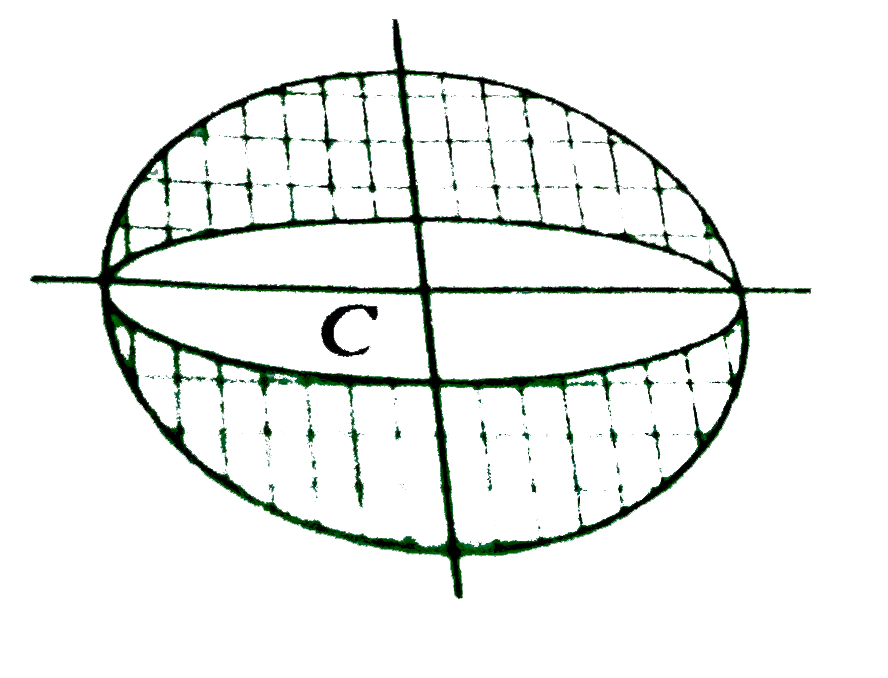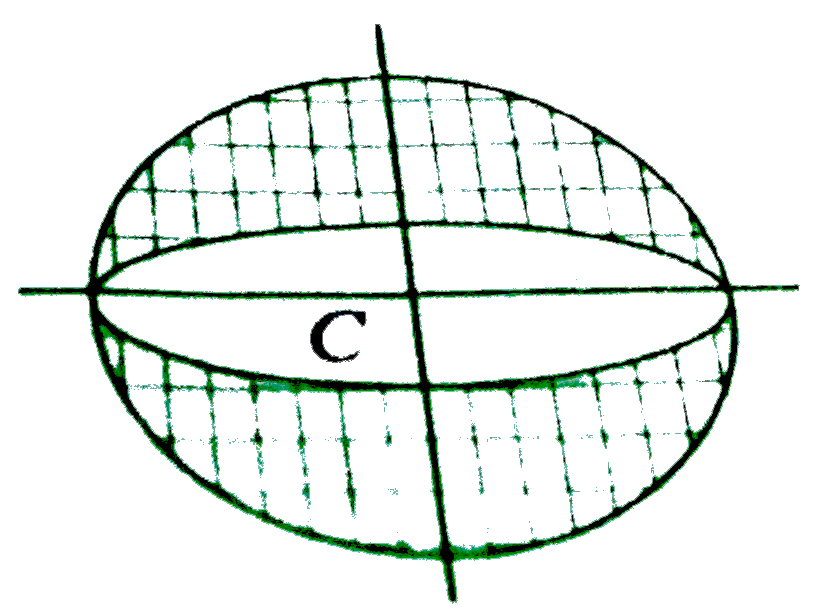An eppipse of eccentricity is inscribed in a circle and a point within the circle is chosen at random. The probability that this point lies outside the ellipse is
The correct Answer is:D
To solve the problem of finding the probability that a randomly chosen point within a circle lies outside an inscribed ellipse with eccentricity 2√23, we can follow these steps:
Step 1: Understand the relationship between eccentricity, semi-major axis, and semi-minor axis
The eccentricity e of an ellipse is given by the formula:
e=ca
where c is the distance from the center to the focus, and a is the semi-major axis. Given e=2√23, we can express c in terms of a:
c=2√23a
Step 2: Use the relationship between a, b, and c
For an ellipse, we have the relationship:
a2=b2+c2
where b is the semi-minor axis. Substituting c from the previous step:
a2=b2+(2√23a)2
This simplifies to:
a2=b2+89a2
Rearranging gives:
b2=a2−89a2=19a2
Thus, we find:
b=13a
Step 3: Determine the semi-major and semi-minor axes
Let’s assume a=3k (since the ellipse is inscribed in a circle, we can scale by k):
b=13(3k)=k
Step 4: Find the area of the ellipse
The area Aellipse of the ellipse is given by:
Aellipse=πab=π(3k)(k)=3πk2
Step 5: Find the area of the circle
The radius of the circle is equal to the semi-major axis a=3k. Thus, the area Acircle of the circle is:
Acircle=πR2=π(3k)2=9πk2
Step 6: Calculate the area outside the ellipse but inside the circle
The area outside the ellipse but inside the circle is:
Aoutside=Acircle−Aellipse=9πk2−3πk2=6πk2
Step 7: Calculate the probability
The probability P that a randomly chosen point inside the circle lies outside the ellipse is:
P=AoutsideAcircle=6πk29πk2=69=23
Thus, the probability that a randomly chosen point lies outside the ellipse is 23.
Final Answer
The probability that a randomly chosen point within the circle lies outside the ellipse is 23.
---
The eccentricity e of an ellipse is given by the formula:
e=ca
where c is the distance from the center to the focus, and a is the semi-major axis. Given e=2√23, we can express c in terms of a:
c=2√23a
For an ellipse, we have the relationship:
a2=b2+c2
where b is the semi-minor axis. Substituting c from the previous step:
a2=b2+(2√23a)2
This simplifies to:
a2=b2+89a2
Rearranging gives:
b2=a2−89a2=19a2
Thus, we find:
b=13a
Let’s assume a=3k (since the ellipse is inscribed in a circle, we can scale by k):
b=13(3k)=k
The area Aellipse of the ellipse is given by:
Aellipse=πab=π(3k)(k)=3πk2
The radius of the circle is equal to the semi-major axis a=3k. Thus, the area Acircle of the circle is:
Acircle=πR2=π(3k)2=9πk2
The area outside the ellipse but inside the circle is:
Aoutside=Acircle−Aellipse=9πk2−3πk2=6πk2
The probability P that a randomly chosen point inside the circle lies outside the ellipse is:
P=AoutsideAcircle=6πk29πk2=69=23
The probability that a randomly chosen point within the circle lies outside the ellipse is 23.
Topper's Solved these Questions
- MODEL TEST PAPER 3BOOK - MTG-WBJEECHAPTER - MODEL TEST PAPER 3EXERCISE - CATEGORY 2 : SINGLE OPTION CORRECT TYPE
15 Videos
- MODEL TEST PAPER 3BOOK - MTG-WBJEECHAPTER - MODEL TEST PAPER 3EXERCISE - CATEGORY 3 : One or More than One Option Correct Type
10 Videos
- MODEL TEST PAPER 2BOOK - MTG-WBJEECHAPTER - MODEL TEST PAPER 2EXERCISE - CATEGORY 3 : One or More than One Option Correct Type
10 Videos
- PERMUTATIONS AND COMBINATIONSBOOK - MTG-WBJEECHAPTER - PERMUTATIONS AND COMBINATIONSEXERCISE - WB JEE Previous years questions (Category 3 : More than One Option correct type)
1 Videos
Similar Questions
An ellipse of eccentricity 2√23 is inscribed in a circle and a point within the circle is chosen at random. Let the probability that this point lies outside the ellipse be p. Then the value of 105 p is
View SolutionAn ellipse is inscribed in a circle and a point within the circle is chosen at random. If the probability that this point lies outside the ellipse is 23 then the eccentricity of the ellipse is: (A) 2√23 (B) √53 (C) 89 (D) 23
View Solution
Knowledge Check
An ellipse of eccentricity 2√23 is inscribed in a circle . A point is chosen inside the cirlce at random. The probaboility that the point lies outside the ellipse is
A12B23C19D29There are some experiment in which the outcomes cannot be identified discretely. For example, an ellipse of eccentricity 2√2/3 is inscribed in a circle and a point within the circle is chosen at random. Now, we want to find the probability that this point lies outside the ellipse. Then, the point must lie in the shaded region shown in Figure. Let the radius of the circle be a and length of minor axis of the ellipse be 2b. Given that
1−b2a2=89orb2a2=19
Then, the area of circle serves as sample space and area of the shaded region represents the area for favorable cases. Then, required probability is
p=Area of shaded regionArea of circle
=πa2−πabπa2=1−ba=1−13=23
Now, answer the following questions.

A point is selected at random inside a circle. The probability that the point is closer to the center of the circle than to its circumference isA1/4B1/2C1/3D1/√2There are some experiment in which the outcomes cannot be identified discretely. For example, an ellipse of eccentricity 2√2/3 is inscribed in a circle and a point within the circle is chosen at random. Now, we want to find the probability that this point lies outside the ellipse. Then, the point must lie in the shaded region shown in Figure. Let the radius of the circle be a and length of minor axis of the ellipse be 2b. Given that
1−b2a2=89orb2a2=19
Then, the area of circle serves as sample space and area of the shaded region represents the area for favorable cases. Then, required probability is
p=Area of shaded regionArea of circle
=πa2−πabπa2=1−ba=1−13=23
Now, answer the following questions.

Two persons A and B agree to meet at a place between 5 and 6 pm. The first one to arrive waits for 20 min and then leave. If the time of their arrival be independant and at random, then the probability that A and B meet isA1/3B1/3C2/3D5/9
An ellipse is inscribed in its auxiliary circle and a point within the circle is chosen at random. If p is the probability that this point lies outside the ellipse and inside the auxiliary circle. Then 8p is equal to (where eccentricity of the ellipse is √32)
(A) 3 (B) 4 (C) 6 (D) 1
View SolutionAn ellipse is inscribed in its auxiliary circle and a point within the circle is chosen at random. If p is the probability that this point lies outside the ellipse and inside the auxiliary circle. Then 8p is equal to (where eccentricity of the ellipse is √32)
(A) 3 (B) 4 (C) 6 (D) 1
View SolutionP is a point within or on the circle x2+y2=r2. The probability that the point P is such that it is above the line y=mx is
View SolutionA square is inscribed in a circle. If pr is the probability that a randomly chosen point inside the circle lies within the square and p, is the probability that the point lies outside the square, then
View SolutionThe point (5,−7) lies outside the circle
View Solution
